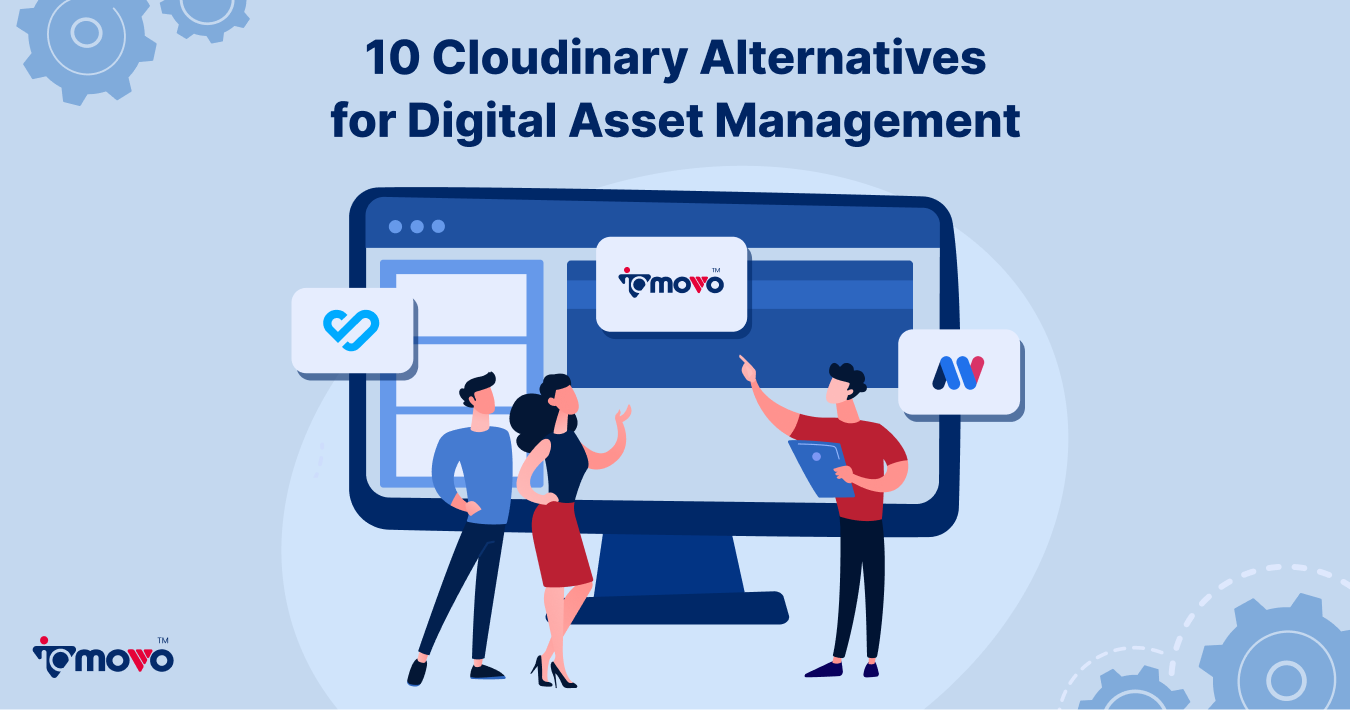The Future of Cloud Storage: Emerging Trends and Innovations
Cloud storage is evolving fast – and it has to.
The volume, variety, and velocity of digital content today are growing at an unprecedented pace. Traditional cloud storage systems, designed to handle small-scale, file-based storage, are quickly becoming inadequate. Teams across industries are hitting their breaking points with: scattered files, sluggish uploads, broken workflows, and zero visibility into what's actually being used.
As a result, teams spend precious time searching for files, dealing with disorganized content, and wrestling with version control issues. These inefficiencies not only slow down projects but also drive up operational costs.
But the future of cloud storage looks radically different.
New, cutting-edge technologies are emerging to transform how we manage and interact with digital content. From AI-powered automation that optimizes workflows to edge computing that reduces latency and increases efficiency, blockchain integrity ensuring secure data transactions, and hybrid cloud architecture offering unmatched flexibility, these innovations are reshaping how businesses operate.
This article will break down the top trends that are revolutionizing cloud storage and show why forward-thinking teams are adopting these technologies now, to stay ahead in an increasingly digital world.
Why Traditional Cloud Storage Isn’t Enough Anymore
Most teams still rely on widely used tools like Dropbox, Google Drive, SharePoint, or OneDrive to store and share content. While these platforms are familiar, affordable, and easy to adopt, they were never designed to handle the exploding volume, complexity, and velocity of modern digital assets.
These systems were built for files, not for workflows. Their purpose was to manage simple storage needs, but today’s teams demand far more than just basic file-sharing solutions.
They weren’t designed for:
- Searching across massive libraries of videos, PDFs, or image variations,
- Managing client feedback, approvals, and version control seamlessly,
- Detecting duplicates, tagging content, or extracting valuable insights,
- Automating delivery pipelines or scheduled publishing,
- Supporting AI-powered organization or intelligent search functionalities.
For teams in creative industries, marketing, and media operations, these limitations result in significant inefficiencies, including:
- Wasted hours spent hunting for files or recreating lost or misplaced work,
- Broken collaboration with feedback scattered across emails, Slack, and cloud links,
- Project delays due to missing versions, inconsistent file names, or manual tagging,
- Lack of visibility into which content is used, reused, or forgotten, leading to missed opportunities.
As digital content grows exponentially, these tools are increasingly failing to meet the needs of modern teams. The core problem isn’t storing files anymore – it’s finding, using, and delivering them efficiently and at scale.
This is why more and more teams are re-evaluating their traditional cloud storage solutions and seeking next-gen platforms that can manage content at scale while embracing automation, AI, and seamless workflows.
Emerging Trends in Cloud Storage
Cloud storage is undergoing a major transformation, driven by decentralization, automation, and AI. From the underlying architecture to how data is secured and optimized, the future of cloud storage is no longer just about storing files – it’s about intelligent, real-time data management that can scale and adapt to the rapidly growing needs of modern teams.
With the explosion of digital content across industries, traditional storage systems can no longer keep up with the increasing volume, variety, and velocity of data.
As a result, new trends are emerging that are redefining how we store, access, and secure our digital assets. Let’s dive into some of the most exciting innovations reshaping the cloud storage landscape.
1. Edge Computing Redefines Cloud Architecture
Edge computing is quickly becoming a game-changer in cloud storage architecture. As an integral part of IT infrastructure, it is reshaping how data is processed, stored, and accessed in real time. By processing data closer to the devices that generate it, edge computing significantly reduces latency, frees up valuable bandwidth, and enables more responsive, decentralized workflows.
The Shift in Storage Architecture
This transition is influencing storage architecture in a variety of ways. For instance, companies are increasingly exploring distributed file systems and object storage located at the edge, closer to data sources. As a result, data can be stored and processed near the point of origin, improving both speed and efficiency.
In addition, partnerships between cloud providers and telecom firms are becoming more prevalent, with these collaborations helping to deploy infrastructure at the network edges. This growing synergy ensures that edge computing becomes a scalable solution, helping businesses meet the demand for faster, more flexible data management.
The Future of Self-Managing Files
With the rapid advancements in edge computing, we could soon see files managing themselves based on usage patterns. Thanks to edge intelligence, files may be able to cache or store themselves locally, depending on how frequently they’re accessed. This approach would give customers the ability to store latency-sensitive data closer to the devices that need it, while still keeping it fully integrated with centralized cloud services.
This means faster data retrieval, reduced bandwidth consumption, and a more efficient cloud storage system that adapts in real time to meet evolving demands.
2. Quantum-Resistant Cloud Security
As quantum computing continues to advance, it holds the potential to revolutionize cloud security – both for better and for worse. While quantum computers offer powerful capabilities, they could eventually break the current cryptographic systems that protect sensitive data in the cloud. The public-key cryptography that underpins much of today’s security infrastructure is vulnerable to quantum attacks, making it crucial for cloud providers to act early in preparing for this future.
Preparing for the Quantum Future
To stay ahead of this emerging threat, cloud platforms are already investing in post-quantum technologies and developing quantum-resistant algorithms. These steps are aimed at fortifying the security of cloud storage and ensuring that sensitive data remains protected even in the face of quantum breakthroughs.
Cloud platforms are also taking proactive steps, including:
- Using hash-based file signatures that are more resistant to quantum attacks
- Developing quantum-resistant algorithms to ensure future-proof data security
- Investing in post-quantum technologies to stay ahead of the curve and safeguard assets from future quantum computing risks
While error-corrected quantum computers are not yet widely available, the risks are real – particularly for industries handling sensitive data like banking, healthcare, or government sectors. These industries rely heavily on encryption to protect confidential information, making them especially vulnerable if quantum computing is used maliciously.
The Future of Quantum Storage
Looking ahead, quantum storage may become an essential component of future cloud solutions. Quantum storage offers the potential for high-density storage capable of handling massive datasets, possibly reaching yottabytes of data. As the volume of data continues to grow exponentially, quantum storage could provide the capacity and scalability needed to meet these demands.
By preparing for quantum security risks today, businesses can ensure that their cloud platforms are ready to handle tomorrow’s challenges and continue to safeguard their most valuable digital assets with the highest level of protection.
AI-Driven Optimization in the Cloud
Artificial intelligence is becoming an integral part of modern cloud infrastructure, fundamentally transforming how data is managed, optimized, and protected. By embedding AI directly into cloud storage systems, businesses can now achieve smarter, faster, and more secure workflows.
How AI Enhances Cloud Storage
Machine learning models are increasingly used to analyze user behavior and predictively auto-categorize files, eliminating the need for manual tagging or organization. AI also optimizes data placement, adjusts replication strategies, and ensures that content is stored in the most appropriate storage tiers, maximizing efficiency and reducing operational overhead.
Beyond simple classification, AI adds advanced operational capabilities, including:
- Deep metadata tagging for faster search, improved governance, and better content discoverability
- Real-time infrastructure provisioning to automatically scale resources based on workload demand
- Anomaly detection that identifies potential hardware degradation or security threats before they cause issues
- Global workload auto-balancing across cloud regions for improved performance and resilience
This AI-first approach makes cloud storage not just scalable, but adaptive allowing platforms to respond intelligently to changing usage patterns, resource demands, and security requirements. Teams benefit from faster access to files, optimized storage costs, and automated management, freeing IT staff to focus on higher-value tasks.
Together, these trends are reshaping what cloud storage can be. It’s no longer just a place to hold files, it’s becoming a dynamic environment that:
- Responds in real time
- Automates manual tasks
- Supports increasingly complex workflows
Edge computing decentralizes architecture. AI optimizes performance and security. Quantum technologies are preparing infrastructure for the next generation of threats and scale.
As these developments continue, we’ll see storage platforms evolve into intelligent systems capable of supporting modern digital demands, with less effort, more control, and greater speed.
Innovations in Cloud Storage Technologies
The world of cloud storage is evolving at a rapid pace, with innovative technologies emerging daily to enhance infrastructure, boost resilience, and expand capabilities. These advancements are pushing the boundaries of what cloud storage can do, making it more secure, scalable, and intelligent than ever before.
From blockchain-based integrity systems to breakthroughs in object storage and hybrid cloud environments, there are several key areas that are redefining the cloud storage experience and offering exciting possibilities for businesses.
Key Areas of Innovation:
- Blockchain-Based Integrity Systems: Blockchain is being integrated into cloud storage to provide tamper-proof integrity, ensuring that data remains secure and unaltered. This innovation is especially beneficial for industries like finance, healthcare, and media, where the authenticity of digital assets is critical.
- Advances in Object Storage: Object storage, which separates metadata from file contents, continues to evolve, enabling businesses to manage unstructured data at scale. New innovations like software-defined storage, open standards, and serverless applications are making object storage more flexible and efficient than ever.
- Hybrid Cloud Solutions: Hybrid cloud storage allows businesses to combine the best of both worlds – on-premises and public cloud storage. This gives organizations the flexibility to store sensitive data on-premises while leveraging the scalability and cost-effectiveness of the cloud.
These innovative technologies are paving the way for a more intelligent and interconnected cloud. As businesses continue to manage larger volumes of data, these developments provide the scalability, flexibility, and security needed to handle today’s complex digital demands.
Toward Smarter, More Flexible Infrastructure
From decentralized file integrity to scalable object storage and hybrid interoperability, these innovations demonstrate a clear direction: cloud storage is evolving into a smarter, more modular, and more interconnected system that adapts seamlessly across different environments.
For IT teams and content-heavy organizations, this evolution unlocks:
- New options for compliance, speed, and scalability that allow businesses to stay agile and responsive to industry changes and regulatory requirements.
- Better collaboration across tools and cloud providers, enabling teams to work fluidly regardless of the platform or provider, ensuring all assets are easily accessible and shareable.
- Infrastructure that evolves alongside business needs, supporting complex workflows and enabling rapid adaptation as digital demands shift.
As these technologies mature, they will lay the groundwork for the next generation of cloud storage, one that prioritizes intelligence, interoperability, and automation. This future-ready infrastructure will make it easier than ever for organizations to scale and optimize their operations, paving the way for more efficient, dynamic, and secure cloud environments.
Benefits of Using ioMoVo’s ioCloud Solution
New technology vendors are playing a major role in advancing cloud storage and ioMoVo stands at the forefront. Designed specifically for modern content teams, ioCloud brings together emerging technologies to solve challenges that traditional storage systems can’t.
Built from the ground up to support creators and collaborators, ioCloud offers clear advantages over outdated or disconnected tools.
- Streamlined capture and upload: Shoot directly into ioCloud folders from any device for effortless cloud storage upon shooting. Auto-uploads free memory while organizing occurs simultaneously in the background.
- On-device performance: Leveraging native storage, ioCloud doesn't impact device performance like separate upload apps can. Content access is also just as speedy as if locally stored.
- Superior organization: Advanced tagging, facial recognition, and intuitive folders keep even massive libraries simple to navigate from any platform. Deep metadata benefits searching.
- Instant multi-device access: Changes sync rapidly across all linked devices. Team members access consistent views whether desktop or mobile for efficient collaboration.
- Studio-quality sharing: Embedded previews and granular access controls optimize distributing content professionally to clients and partners through shareable online folders.
- Powerful automation: Background AI analysis extracts metadata and summaries while screen recording and camera modes expedite common tasks through intuitive few-tap workflows.
- Cost leadership: All ioCloud Modern Cloud Storage tiers provide generous and steadily growing included storage that outpaces proprietary competitors relying on upsells and extra fees to fund similar tools and security.
- Mobile first design: Built specifically for today's content needs utilizing cutting-edge smartphones as both shooting and editing hubs for location work while still accommodating traditional uses.
- Industry standards: Full compliance with standards like S3 ensures interoperability and future-proofs assets even beyond any single vendor's lifespan through easy extraction if required.
These aren’t just technical specifications – they’re enablers of better work.
The real value of ioCloud lies in how it helps teams operate faster, smarter, and with less friction. To understand the impact, it’s worth zooming out from features and looking at what these innovations mean in practice.
Why These Innovations Matter for Your Team
Edge computing, AI metadata tagging, and hybrid architecture might sound like technical upgrades on paper, but their real-world impact is far more practical. These innovations directly solve the everyday challenges that creative, operational, and content-heavy teams face as they work to streamline workflows, manage digital assets, and deliver projects faster.
Here’s why these innovations matter for your team:
1. Speed Isn’t a Luxury – It’s a Necessity
Every delay caused by slow syncs, missing files, or scattered storage adds up. These inefficiencies can lead to project slowdowns, missed deadlines, and wasted time. But with edge computing, AI search, and real-time sync, your team can move faster, whether collaborating across cities or reviewing edits on tight deadlines. Speed is no longer just a nice-to-have – it’s the foundation of a productive and competitive team.
2. Manual Work Creates Bottlenecks
Repetitive tasks like tagging assets, sorting files, and updating folders are time-consuming, error-prone, and often skipped under pressure. Automation powered by AI takes care of these tasks behind the scenes, freeing your team to focus on what truly matters: creating, managing, and delivering high-quality work. By eliminating manual work, teams can avoid bottlenecks and keep projects moving forward smoothly.
3. Content Chaos Kills Collaboration
When assets are scattered across multiple drives or stored with inconsistent file names, version control becomes a guessing game. Collaboration becomes a hassle when team members don’t know which version of a file they should be using. With smart, centralized access and AI-driven organization, teams always know they’re working from the right file, eliminating the need for Slack chases or email threads. This leads to better collaboration and more efficient workflows.
4. You Can’t Reuse What You Can’t Find
Many teams are sitting on content goldmines – videos, graphics, transcripts, proposals – that are buried in disorganized folder structures. Without a powerful way to search and discover these assets, they go underused or forgotten. AI-powered platforms don’t just store content; they surface it. By bringing relevant assets to the forefront, your team can reuse content more efficiently, increasing ROI and reducing the need to recreate what already exists.
When Is the Right Time to Switch?
Many teams wait too long to modernize their storage systems – assuming their current setup is “fine for now.” But the signs of friction usually show up long before the tipping point.
Here are a few clear signals it’s time to move on from traditional storage tools:
- You’re storing assets across 3+ platforms (Google Drive, Dropbox, Frame.io, SharePoint…)
- You’ve lost time or missed deadlines because of version confusion or missing files
- You’re recreating content you know probably exists somewhere
- Approvals, feedback, and delivery are scattered across tools (Slack, email, file links)
- You’ve added new team members or freelancers and onboarding them is chaotic
- You’ve outgrown your current plan, but upgrading means more cost, not more capability
These challenges are common, but they’re also signals that your team has outgrown generic storage tools.
ioMoVo is built for this exact transition: when content demands have scaled, but traditional platforms can’t keep up.
Cloud storage is no longer just a utility – it has become a strategic enabler of speed, collaboration, and scalability.
As data volumes grow exponentially and workflows become more complex, traditional storage systems are no longer sufficient. The platforms we rely on must evolve to meet the demands of today’s digital-first environment. The trends shaping the future of cloud storage – AI, edge computing, blockchain, and hybrid infrastructure – are not theoretical. They are already transforming how modern teams create, manage, and deliver content.
The shift is clear: Storage alone isn’t enough. Intelligence, automation, and interoperability are no longer optional; they are essential for teams to stay competitive and agile in today’s fast-moving digital landscape.
Teams that adapt to these innovations will move faster, work smarter, and unlock more value from their content than ever before – resulting in higher productivity, collaboration, and cost savings.
Whether you’re leading a creative studio, managing enterprise media, or optimizing internal workflows, the message is clear: Modernize now or risk falling behind.
If you think ioMoVo could help you achieve this, book a demo and see how our AI-powered cloud storage solution can streamline your workflows and unlock new efficiencies for your team.
املأ النموذج أدناه للبدء!
Transform How Your Organization Manages Content
Unlock hidden value in your content with AI — faster discovery, better workflows, and organized collaboration
Ready to see how ioMoVo can fit your team?







.svg)